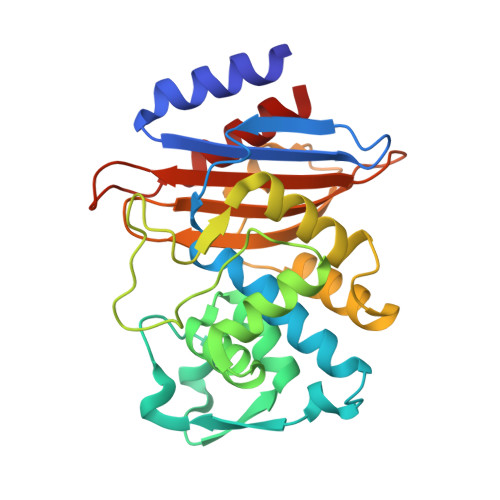The Drug-Resistant Variant P167S Expands the Substrate Profile of CTX-M beta-Lactamases for Oxyimino-Cephalosporin Antibiotics by Enlarging the Active Site upon Acylation.
Patel, M.P., Hu, L., Stojanoski, V., Sankaran, B., Prasad, B.V.V., Palzkill, T.(2017) Biochemistry 56: 3443-3453
- PubMed: 28613873
- DOI: https://doi.org/10.1021/acs.biochem.7b00176
- Primary Citation of Related Structures:
5TW6, 5TWD, 5TWE, 5U53, 5VTH - PubMed Abstract:
CTX-M β-lactamases provide resistance against the β-lactam antibiotic, cefotaxime, but not a related antibiotic, ceftazidime. β-Lactamases that carry the P167S substitution, however, provide ceftazidime resistance. In this study, CTX-M-14 was used as a model to study the structural changes caused by the P167S mutation that accelerate ceftazidime turnover. X-ray crystallography was used to determine the structures of the P167S apoenzyme along with the structures of the S70G/P167S, E166A/P167S, and E166A mutant enzymes complexed with ceftazidime as well as the E166A/P167S apoenzyme. The S70G and E166A mutations allow capture of the enzyme-substrate complex and the acylated form of ceftazidime, respectively. The results showed a large conformational change in the Ω-loop of the ceftazidime acyl-enzyme complex of the P167S mutant but not in the enzyme-substrate complex, suggesting the change occurs upon acylation. The change results in a larger active site that prevents steric clash between the aminothiazole ring of ceftazidime and the Asn170 residue in the Ω-loop, allowing accommodation of ceftazidime for hydrolysis. In addition, the conformational change was not observed in the E166A/P167S apoenzyme, suggesting the presence of acylated ceftazidime influences the conformational change. Finally, the E166A acyl-enzyme structure with ceftazidime did not exhibit the altered conformation, indicating the P167S substitution is required for the change. Taken together, the results reveal that the P167S substitution and the presence of acylated ceftazidime both drive the structure toward a conformational change in the Ω-loop and that in CTX-M P167S enzymes found in drug-resistant bacteria this will lead to an increased level of ceftazidime hydrolysis.
Organizational Affiliation:
Department of Molecular Biophysics and Integrated Bioimaging, Berkeley Center for Structural Biology, Lawrence Berkeley National Laboratory , Berkeley, California 94720, United States.
















